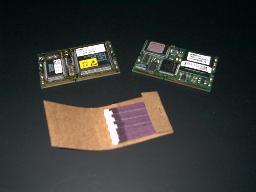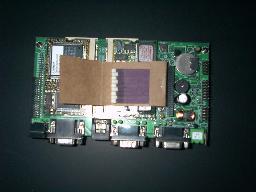ELJonline: Smaller than a Paperback
Jan 1, 2001 — by LinuxDevices Staff — from the LinuxDevices Archive — viewsHow to install, configure and run a complete Linux system on a tiny 486-class machine with no moving parts.
In this article, we'll focus on experimenting with Embedded Linux. We'll step through setting up EMJ's White Dwarf Linux on a Jumptec DIMM-PC system. The entire OS and applications will live on the DIMM-PC's onboard flash disk.
The DIMM-PC is a full-featured 486SX with 16MB of built-in IDE-compatible flash and 16MB of RAM, all smaller than a credit card. Also available are DIMM-IO modules that are the same size as the DIMM-PC but offer I/O capabilities such as Ethernet and VGA. We'll be using the DIMM-PC Combo module that provides I/O capabilities for Ethernet, VGA and two serial ports.

Figure 1. Jumptec's DIMM-PC and I/O Modules
I'll describe how to install a fully functional Linux system, complete with web server, on the DIMM-PC's onboard flash. We'll have a fully operational Linux system the size of a paperback, with VGA, Ethernet and no moving parts!
What You Will Need
The DIMM-PC is tiny. However, the raw form has limited usefulness. You can't plug things like Ethernet, VGA and so on into the high-density cardedge of the DIMM-PC. You need a carrier board to expand the DIMM-PC's cardedge into useful real-world connectors like keyboard, mouse, IDE, VGA and so forth.
To get your DIMM-PC up and running easily, you will need the following items:
- Jumptec's 486 DIMM-PC Module (16MB RAM, 16MB IDE-compatible Flash)
- Jumptec's DIMM-PC Combo Module (VGA, Ethernet, 2x RS232 serial ports)
- DIMM-PC Evaluation Board
- Mite PC-S Carrier Board
Observe proper Electrostatic Device (ESD) handling precautions with these sensitive components.
You will also need:
- An Ethernet network connection to the Internet
- A 1.44MB 3.5″ floppy disk drive and two diskettes
- Keyboard and monitor
- Power Supply (a PC's power supply works fine)
Step One: Preparing to Install
First, you will need a boot diskette and a root diskette. Images are available for download from the White Dwarf Linux page (see Resources).
Next, plug the DIMM-PC and the DIMM-PC Combo I/O modules into the proper slots on the evaluation board. Also plug in a keyboard, monitor, floppy drive and your Ethernet connection to the Internet. Plug power into the evaluation board and the floppy drive and power up.
When the system boots, the first thing you need to do is enter the BIOS setup and set the date and time. Without the proper date and time, some system functions and utilities may behave erratically. You need to do this every time the DIMM-PC is removed from its housing, as the battery needed for storing the BIOS settings is on the carrier board and not on the DIMM-PC itself. That means each time the DIMM-PC card is removed from the carrier board, the BIOS loses its settings.
Step Two: Installation
Once the BIOS date and time are set and saved, place the boot disk into the floppy drive and reboot. You will see something like this in the messages that go by:
RAM disk driver initialized:
16 RAM disks of 8192K size
hda: SunDisk SDTB-128, ATA DISK drive
ide0 at 0x1f0-0x1f7,0x3f6 on irq 14
hda: SunDisk SDTB-128, 15MB w/1kB Cache, CHS=490/2/32
You will then be prompted for the root disk. Once the root disk loads, the installer for White Dwarf Linux will run. Follow the onscreen instructions for setting up White Dwarf Linux and installing any optional packages, including a stripped-down Apache web server. Installing all available packages can take up to 50MB, so be choosy in what you select, since there are only 16MB of flash. You can add more software later.
Detailed information about the White Dwarf Linux installer and the specific packages is available at the EMT web site (see Resources).
When the installation is complete, remove the floppy disk from the drive and press the reset button. Your DIMM-PC should boot up. Log in and take a look around to make sure everything is working to your satisfaction.
Step Three: Moving to a Smaller Footprint
You can leave the DIMM-PC as is at this point, but more likely, you'll want to transplant the DIMM-PC modules to something a little smaller than the large evaluation board. This is what the Mite PC-S board is for.

Figure 2.The Mite PC-S Carrier Board
The Mite PC-S carrier board holds the DIMM-PC, the DIMM-PC I/O module and provides connectors for everything except a floppy drive. This is why we need the main evaluation board–to boot from floppy to install White Dwarf Linux on the onboard flash disk. The DIMM-PC must be able to boot on its own before moving to the smaller Mite PC-S carrier board.
If the installation of White Dwarf Linux has gone well, shut down the system (use shutdown -h now) and power off. Then, remove the DIMM-PC and the DIMM-PC I/O cards from the evaluation board and insert them into the proper slots on the Mite PC-S board. Also plug in a monitor and keyboard and your Ethernet connection. You may also wish to add nylon standoffs to the Mite PC-S board or perhaps purchase the plastic enclosure specially made for the Mite PC-S (see Resources).
Step Four: Powering the Mite PC-S Carrier Board
The Mite PC-S carrier board requires +5V regulated power (+/- 5%) and consumes between 0.75 and 1.3 amps, with spikes on power-up. The Mite PC-S board has a removable screw terminal power connector plug-in that you can insert wires into for +5V and GND. Your power supply should be rated for up to 3 amps and should be able to handle brief spikes past that. If your power supply of choice is not fused, I would also recommend placing a suitable fuse inline with the +5V supply for protection should the worst happen.
So where do you get +5V? It can be provided in many ways. Some examples are:
- Use a PC Power Supply. If you do this, take one of the power connectors (Black = GND, Red = +5V) and cut off the head. Strip a red wire and a black wire, then insert them into the appropriate receptacles in the screw terminal plug for the Mite PC-S board.
- Use a Switching Wall Transformer Power Supply. These are special-purpose wall transformers made to deliver a properly conditioned +5V supply. They are very different from a conventional wall transformer power supply. Wall transformers do not normally output a regulated supply. Cut the plug off the power supply, strip the ends and determine which is +5V and which is GND with a voltmeter. Insert the wires into the appropriate receptacles in the screw terminal plug for the Mite PC-S board.
- Design Your Own DC Power Supply. If you have sufficient electrical/electronics knowledge, you may wish to design your own power supply around an integrated DC-DC converter such as the Power Trends PT6302 (see Resources). Such a design is powered from a DC source and can be used to condition power from an unregulated DC power source such as a conventional high-current wall adapter, a car's +12V cigarette lighter plug or even a portable battery source.
Whenever working with power, always be careful to get the polarity right. Reversing the +5V and GND feeds can and will damage or destroy your equipment. Double- and triple-check with a voltmeter before powering anything up.
When you have a proper power supply created and tested, plug your power into the Mite PC-S board and watch it boot up.
Step Five: Finishing Up
Since we removed the DIMM-PC from the evaluation board to move it to the Mite PC-S board, we will need to set the proper date and time in the BIOS once again.
Upon boot up, enter the BIOS and set the proper date and time. While you are here, you can make other customizations. Some recommended changes to consider are turning on fast boot, ignore missing keyboard and monitor, no floppy drive and possibly reducing the CPUs speed from 66MHz to 33MHz. This will reduce current draw and therefore overall power consumption. This may be desirable if you can live with 33MHz and especially if you are running the DIMM-PC from a battery source. Save your new BIOS settings and reboot.
Congratulations! You now have a fully functional Linux system that is smaller than a paperback, has no moving parts and is possibly battery-powered.
Additional Information
You do not need to use White Dwarf Linux with the DIMM-PC. You can install anything you like, as the DIMM-PC is a fully functional 486. If you decide to use other distributions, it is recommended you add storage space in addition to the 16MB onboard flash disk. Some alternatives are:
- a 2.5″ laptop hard drive (connects to the IDE header on the MITE-PC board via a 44-pin IDE cable)
- a Compact Flash drive (available adapter to connect a CF drive to the MITE-PC listed below)
You can connect a normal hard drive or CD-ROM drive, but you will require a 40- to 44-pin IDE cable. You will also need to provide power to the hard drive or CD-ROM.
If you use a laptop hard drive, power is supplied to the drive through the 44-pin cable.
Other Ways to Get Started with the DIMM-PC
- Don't want to buy an evaluation board just for the floppy controller? Pre-load your selected flavor of Linux onto a hard drive and plug it into your DIMM-PC (I have not experimented with this).
- Create a bare-bones DIMM-PC web server (does not require a carrier board) at wearables.stanford.edu in the Do-It-Yourself Department.
- If you don't mind paying for a prefab solution, purchase a pre-built (and tiny) DIMM-PC system complete with Compact Flash drive from www.tiqit.com.
Specific Power Supply Suggestion
I have recently been testing a power supply of the regulated wall transformer variety from CUI Stack (Digi-Key part #T930-ND) that can output 2800mA at +5V within 5%. Despite providing up to 2800mA, it doesn't seem to cough up enough to carry the DIMM-PC through its power-up spike when the DIMM-PC is running at 66MHz. However, if I set the DIMM-PC to 33MHz in the BIOS, it seems to work okay. If you try this, please let me know how it works out for you.
About the author: Don Papp is a hardware designer and Linux enthusiast who enjoys robotics, poker, and movies. He welcomes your comments or questions to [email protected] and is always interested in hearing about interesting projects and to what uses people put their embedded systems.
Copyright © 2001 Specialized Systems Consultants, Inc. All rights reserved. Embedded Linux Journal Online is a cooperative project of Embedded Linux Journal and LinuxDevices.com.
This article was originally published on LinuxDevices.com and has been donated to the open source community by QuinStreet Inc. Please visit LinuxToday.com for up-to-date news and articles about Linux and open source.